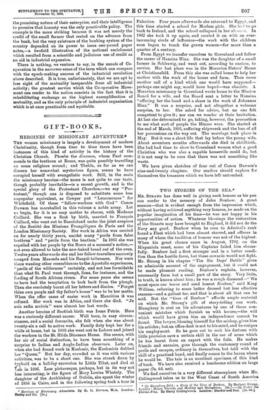G-IFT-BOOKS.
HEROINES OF MISSIONARY ADVENTURE.* THE woman missionary is largely a development of modern Christianity, though from time to time there have been instances of this kind of activity in the history of the Christian Church. Phoebe the diaconos, whom Paul com- mends to the brethren at Rome, was quite possibly travelling on some religious errand ; and Thekla, as far as we can discern her somewhat mysterious figure, seems - to have occupied herself with evangelistic work. Still, in the main the missionary heroine—the name is not quite to our taste, though probably inevitable—is a recent growth, and is the special glory of the Protestant Churches,—we say "Pro- testant," though one is disposed to substitute some less unpopular equivalent, as Cowper put " Leuconomus " for Whitefield. Of these "fellow-workers with God" Canon Dawson has marshalled in this volume a noble array. Let us begin, for it is no easy matter to choose, with Madame Coillard. She was a Scot by birth, married to Francois Coillard, who went out to Basutoland under the joint auspices of the Societe des Missions .Evangeliques de Paris and the London Missionary Society. Her work in Africa was carried on for nearly thirty years, amidst many "perils from false brethren" and "perils from the heathen." In 1865 she was expelled, with her people by the Boers at a moment's notice,— not even allowed to take the new-baked bread out of the oven. Twelve years. afterwards she and her fellow-travellers narrowly escaped from Masonda and his Banyai tribesmen. Nor were there wanting other resemblances to the Apostolic experiences, "perils of the wilderness" certainly, and not less formidable than what St. Paul went through, lions, for instance, and the fording of South African rivers. For some years she seems to have had the temptation to look back from the plough. Then she resolutely burnt all her letters and diaries. "Forget thine own people and thy father's house" was to be her motto. When the offer came of easier work in Mauritius it was refused. Her work was in Africa, and there she died. " Je suis enfin. arrive° " were almost her last words.
Another heroine of Scottish birth was Irene Petrie. Hers was a curiously different career. Well born, in easy circum- stances, and a social favourite, she felt when she was about twenty-six a call to active work. Family duty kept her for a while at home, but in 1893 she went out to Lahore and joined the workers in the Sb. Hilda Diocesan Home. She seems, with her air of social distinction, to have been something of a surprise to Indian and Anglo-Indian observers. Later on, when she had found work in Kashmir, the Kashmiris dubbed her "Queen." But her day, crowded as it was with various activities, was to be a short one. She was struck down by Vp12014 on R holiday excursion to Little Tibet, and died at Leh in 1896. Less 'picturesque, perhaps, bat in its way not less interesting, is the figure of Mary Louisa Whately. The daughter of the Archbishop of Dublin, she spent the winter of 1856 in Cairo, and in the following spring took a tour in * Heroines of Missionary Adventure. By E. C. Dawson, M.A. London: Seeley and Co. Ds. j Palestine. Four years afterwards she returned to Egypt, and this time started a school for Moslem girls. She hafl to go back to Ireland, and the school collapsed in her ab3ence. In 1862 she took it up again, and carried it on with an ever- increasing circle of influence—the work with the children soon began to touch the grown women—for more than a quarter of a century.
From Egypt we transfer ourselves to Greenland and follow the career of Hansina Hinz. She was the daughter of a small farmer in Schleswig, and went out, according to custom, to service. Her last place was in the Moravian Sisters' Home at Christiansfeld. From this she was called home to help her mother with the work of the house and farm. Then came another call of a kind which one would have supposed— perhaps one might say, would have hoped—was obsolete. A Moravian missionary in Greenland wrote home to the Mission Board for a wife, and the Board sent a letter to Hansina "offering her the hand and a share in the work of Jobannes Hinz." It was a surprise, and not altogether a welcome surprise, to her. She asked for advice, but no one felt competent to give it; nor can we wonder at their hesitation. At last she determined to go, taking, however, the precaution to see what sort of people the Hinzes were. She started at the end of March, 1895, suffering shipwreck and the loss of all her possessions on the way out. The marriage took place in May. But it was a short life that lay before the young wife. About seventeen months afterwards she died in childbirth. She had had time to show to Greenland women what a good Christian who was also a capable housewife could do, but it is not easy to be sure that there was not something like waste.
We have given sketches of four out of Canon Dawson's nine-and-twenty chapters. Our readers should explore for themselves the treasures Which we have left untouched.
































































 Previous page
Previous page